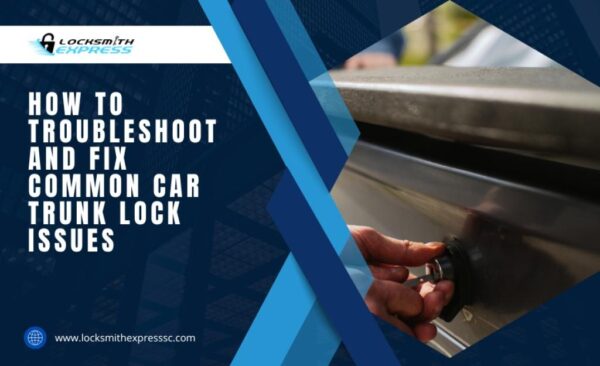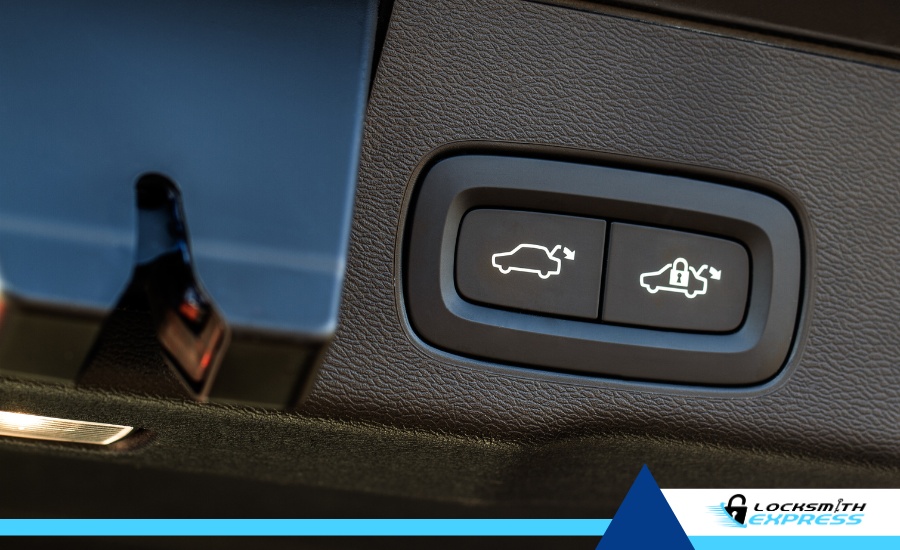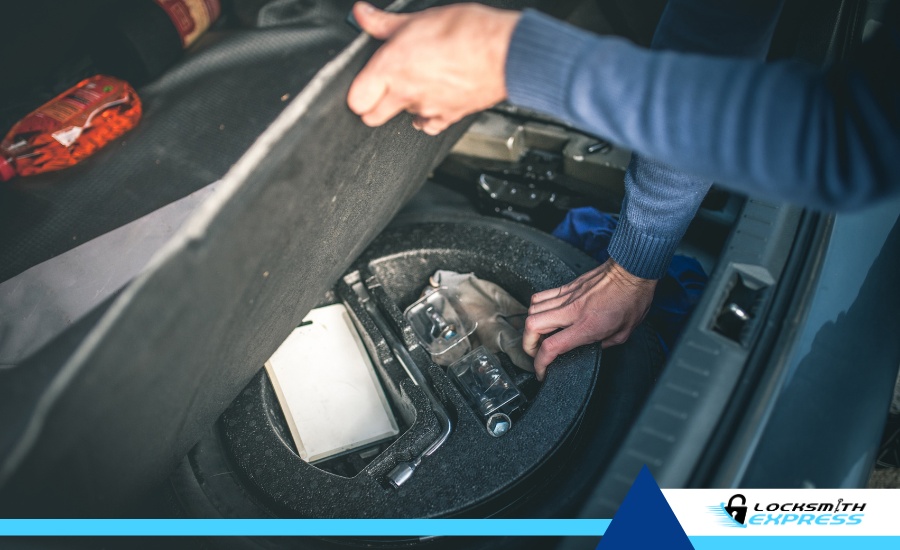Understanding the role and functionality of your car trunk lock is more important than you might realize. It's not just about keeping your belongings safe; it's about ensuring the overall security and integrity of your vehicle. We're going to explore everything from the basics of how trunk locks work to how you can maintain and repair them. Think of this as your go-to guide for keeping your car's trunk lock in top shape.
- Understanding Car Trunk Locks
- Evolution: From Manual to Electronic Trunk Locks
- The Era of Manual Trunk Locks
- Transition to Electronic Lock Systems
- Modern Innovations in Trunk Lock Technology
- The Future of Trunk Locks
- Anatomy of a Car Trunk Lock
- Key Components: Latch, Actuator, Cylinder
- Comparing Trunk Locks and Door Locks: Differences in Design and Function
- Design Variations
- Functional Differences
- The Importance of Trunk Locks in Vehicle Security
- Role of Trunk Locks in Overall Vehicle Safety
- Consequences of a Compromised Trunk Lock
- Increased Risk of Theft
- Common Issues with Car Trunk Locks
- Identifying Signs of Wear and Malfunction
- The Silent Battle: Wear and Tear Over Time
- Physical Damage: Visible Signs and Underlying Causes
- Electrical Issues: Trunk Lock Actuator and Wiring
- Temperature Effects: Cold, Heat, and Moisture
- Step-by-Step Guide to Trunk Lock Repair
- 1. Cleaning and Maintenance: A Preventive Approach
- 2. Fixing the Actuator: A Common Culprit
- 3. Latch Adjustment for Better Functionality
- 4. When to Replace: Assessing Lock Condition
- DIY Repair vs. Professional Assistance
- Evaluating DIY Repair: When It's Feasible
- Risks and Challenges of DIY Trunk Lock Repair
- The Benefits of Professional Locksmith Services
- Prolonging the Life of Your Trunk Lock
- Regular Maintenance Tips
- Best Practices: Do's and Don'ts for Lock Care
- Do's
- Don't's
- Early Detection: Spotting Small Issues Before They Escalate
- Regularly Review Lock Performance
- Conclusion
- Frequently Asked Questions
- Why won't my car trunk lock turn even when I use the right key?
- How often should I lubricate my trunk lock?
- Can I replace the trunk lock actuator myself, or should I get a professional?
- What should I do if my trunk lock is frozen due to cold weather?
- Are electronic trunk locks more reliable than traditional keyed locks?
- Need Expert Assistance? Contact Locksmith Express
Understanding Car Trunk Locks
Like the heart in our body, the trunk lock is a vital part of your car's security system. It works in a pretty straightforward way, but its importance can't be overstated. Originally, these locks were manual, requiring a key to unlock them. However, as technology advanced, so did trunk locks. Now, many cars have electronic locks that can be controlled with the push of a button.
Evolution: From Manual to Electronic Trunk Locks
The evolution of car trunk locks from manual to electronic systems marks a significant leap in automotive technology and convenience, much like the transition from hand-written letters to emails. This change has brought about faster, more efficient, and secure locking mechanisms.
The Era of Manual Trunk Locks
In the beginning, manual trunk locks were the norm. These locks required physical keys to unlock, much like a traditional padlock. The simplicity of this design had its charm but also limitations in terms of security and convenience.
- Key-Based Mechanisms: These locks worked with unique keys, making them somewhat secure but also susceptible to being picked or duplicated.
- Mechanical Wear and Tear: Over time, manual locks could wear down, leading to issues like jamming or difficulty in turning the key.
Transition to Electronic Lock Systems
The shift to electronic trunk locks brought a new level of sophistication and ease to vehicle security. These systems use electronic signals to lock and unlock, eliminating the need for physical keys.
- Remote Access and Control: One of the biggest advantages of electronic locks is the ability to control them remotely, often via a key fob. This feature allows for quick and easy access to the trunk without physical contact with the lock.
- Enhanced Security Features: Electronic locks often come with advanced security features like rolling codes, which change the unlock code after each use, making them much harder to breach than traditional locks.
Modern Innovations in Trunk Lock Technology
Today's electronic trunk locks represent the pinnacle of lock technology, incorporating a range of features for enhanced security and user convenience.
- Integration with Central Locking Systems: Modern electronic locks are often part of the car's central locking system, allowing for seamless control over all locks in the vehicle.
- Smart Features: Some electronic locks can be controlled through smartphone apps, offering features like location tracking and personalized access permissions.
The Future of Trunk Locks
The future of trunk locks is likely to see further integration with digital technologies, potentially incorporating biometric access, such as fingerprint or facial recognition, for even greater security and convenience.
- Biometric Security: Imagine opening your trunk with just a touch or a look, similar to unlocking a smartphone.
- Internet of Things (IoT) Integration: With IoT, trunk locks might be controlled and monitored through a network of connected devices, offering real-time security alerts and remote access capabilities.
Anatomy of a Car Trunk Lock
The trunk lock of a car, often unnoticed, plays a vital role in vehicle security and functionality. Just like a puzzle, it is composed of several key components, each essential in ensuring the lock performs its duty effectively. Understanding these components helps in both maintenance and troubleshooting.
Key Components: Latch, Actuator, Cylinder
The Latch
- Function: The latch is the component that physically holds the trunk closed. It acts like a gatekeeper, ensuring that the trunk remains securely locked until intentionally opened.
- Design: Typically made of sturdy metal, the latch is designed to withstand significant force, preventing unauthorized access.
- Operation: When the trunk lock is engaged, the latch hooks onto a fixed bar or a catch within the trunk, creating a secure lock.
The Actuator
- Function: The actuator is the driving force behind the lock's operation in electronic trunk lock systems. It's the muscle that moves the latch into the locked or unlocked position.
- Types: Actuators can be either electric or pneumatic, depending on the vehicle's design. Electric actuators are more common in modern cars.
- Mechanism: When activated, the actuator moves a rod or lever connected to the latch, either locking or unlocking the trunk.
The Lock Cylinder
- Function: In manual trunk locks, the lock cylinder is where you insert the key. It's the interface between the key and the mechanical parts of the lock.
- Design: The cylinder contains a series of pins or wafers that align with the key's unique cut, allowing the lock to turn and operate the latch.
- Security: The complexity of the lock cylinder's design contributes to the lock's overall security, with more intricate designs offering higher security levels.
Comparing Trunk Locks and Door Locks: Differences in Design and Function
While trunk locks and door locks serve a similar basic purpose – securing parts of your car – their design and function have some notable differences.
Design Variations
- Robustness: Trunk locks are typically designed to be more robust than door locks. This is because the trunk often houses valuable items and is a less visible entry point, requiring extra security.
- Mechanism: The locking mechanism of trunk locks is often different. For instance, the latch system in trunk locks is usually more complex, providing an additional layer of security.
Functional Differences
- Access and Control: Trunk locks, especially in modern cars with electronic systems, can be controlled remotely, which is not always the case with door locks.
- Usage Frequency: Door locks are used more frequently than trunk locks, which can influence the wear and tear they experience and the design considerations for durability.
The anatomy of a car trunk lock is an intricate system, comprising the latch, actuator, and lock cylinder. Each component plays a critical role in ensuring the trunk's security.
The Importance of Trunk Locks in Vehicle Security
The trunk lock, often overlooked, plays a crucial role in the overall security and safety of a vehicle. Just like a helmet for a bike rider, it provides a layer of protection, not only for the belongings inside the trunk but also for the vehicle as a whole.
Role of Trunk Locks in Overall Vehicle Safety
Integral to Vehicle Security
- Protection of Valuables: The primary role of trunk locks is to secure the items inside the trunk. From personal belongings to essential car tools, the trunk often contains valuables that need protection.
- Deterrent to Theft: A robust trunk lock acts as a deterrent to potential thieves. Knowing that breaking into the trunk will be challenging can prevent attempts at theft.
Contribution to Structural Integrity
- Support in Vehicle Design: In some vehicle designs, the trunk lock mechanism contributes to the overall structural integrity of the car. A well-functioning lock ensures that the trunk remains firmly closed, maintaining the vehicle's aerodynamics and stability.
- Safety in Accidents: In the event of a collision, a secure trunk lock helps keep the trunk closed, preventing the ejection of any items from the trunk, which could pose additional hazards.
Consequences of a Compromised Trunk Lock
Increased Risk of Theft
- Vulnerability to Break-ins: A compromised or weak trunk lock makes your vehicle an easy target for theft. It's akin to leaving the front door of your house unlocked, inviting unwanted intrusions.
Safety Hazards
- Compromised Vehicle Safety: During driving, especially at high speeds or in rugged conditions, a malfunctioning trunk lock can lead to the trunk unexpectedly opening. This not only endangers the items inside but can also be a significant distraction and hazard to the driver and others on the road.
- Impact on Accident Safety: In an accident, a faulty trunk lock can result in the trunk popping open, leading to a risk of injury from flying debris. It also affects the structural integrity of the vehicle in a crash scenario, potentially leading to more severe damage and injury.
The importance of a well-maintained and functional trunk lock extends beyond the security of belongings. It plays a vital role in the overall safety and integrity of the vehicle, contributing to both theft prevention and structural stability. Neglecting the health of your trunk lock not only risks your valuables but can also compromise the safety of your driving experience.
Common Issues with Car Trunk Locks
Car trunk locks, much like other mechanical components, can encounter a range of issues over time. Being aware of these common problems can help you address them promptly, ensuring the longevity and functionality of the lock.
Identifying Signs of Wear and Malfunction
Key Indicators
- Difficulty in Operation: One of the first signs of a problem is difficulty locking or unlocking the trunk. If you find yourself having to jiggle the key or apply extra force, it's a clear indicator that something's amiss.
- Strange Noises: Unusual noises when operating the trunk lock - such as grinding or clicking sounds - can signal internal wear or damage.
- Improper Closure: A trunk that doesn't close properly or pops open spontaneously is a red flag. This not only compromises security but also indicates a potential mechanical failure.
Causes of Wear
- Frequent Use: Regular opening and closing of the trunk can gradually wear down the lock mechanism.
- Dirt and Debris: The accumulation of dirt and debris inside the lock can hinder its function and cause premature wear.
- Age of Vehicle: Over time, the lock mechanism can naturally degrade, especially in older vehicles.
- Environmental Impact: How Weather Affects Locks
Temperature Extremes
- Heat and Cold: Extreme temperatures can affect the metal components of the lock, causing them to expand or contract. This can lead to difficulty in turning the key or engaging the lock mechanism.
- Moisture and Corrosion: Rain and snow can introduce moisture into the lock, leading to rust and corrosion. This not only damages the lock but can also freeze in cold weather, rendering the lock inoperable.
Preventive Measures
- Regular Cleaning: Keeping the lock clean from dirt and moisture can prevent many weather-related issues.
- Lubrication: Using appropriate lubricants can protect against rust and ensure smooth operation in varying temperatures.
The Silent Battle: Wear and Tear Over Time
Inevitable Aging
- Gradual Deterioration: Like any mechanical component, trunk locks undergo wear and tear. Continuous use and exposure to the elements can degrade the lock's internal mechanisms.
- Material Fatigue: The materials used in the lock, primarily metals, can weaken over time due to repeated stress and environmental factors.
Mitigation Strategies
- Regular Inspections: Conducting periodic checks can help identify early signs of wear.
- Timely Repairs: Addressing issues as soon as they are noticed can prevent further deterioration and potentially costly repairs.
Understanding the common issues with car trunk locks and recognizing the signs of wear and malfunction is crucial in maintaining your vehicle's security and functionality. Regular maintenance and being mindful of environmental impacts can greatly extend the life and reliability of your trunk lock.
Diagnosing Trunk Lock Problems
Effective diagnosis of trunk lock problems is essential in ensuring the security and functionality of your vehicle. Understanding the common issues can help pinpoint the root cause and determine the best course of action for repair.
Physical Damage: Visible Signs and Underlying Causes
External Damage
- Visible Marks: Physical damage, such as dents or scratches on or around the lock, can be a clear indicator of attempted forced entry or accidental impacts. This kind of damage can compromise the lock's integrity and functionality.
- Misalignment: A trunk lock that appears misaligned may have been subjected to physical stress, potentially affecting its ability to latch properly.
Internal Wear
- Broken Components: Internal components can break due to force or wear, leading to a malfunctioning lock. This might require disassembly to inspect and repair.
- Debris Accumulation: Sometimes, the issue isn’t just on the surface. Dust, grime, or rust inside the lock mechanism can cause it to stick or fail.
Electrical Issues: Trunk Lock Actuator and Wiring
Actuator Problems
- Symptoms: If your electronic trunk lock isn't responding to remote commands or is functioning erratically, it could be a sign of actuator problems. The actuator is the electronic motor that controls the lock mechanism.
- Diagnosis: Checking the actuator involves inspecting for electrical faults, such as loose connections or worn-out components.
Wiring Issues
- Faulty Connections: Over time, the wiring of the trunk lock system can become loose or damaged, leading to intermittent or complete failure of the lock.
- Electrical Shorts: Electrical shorts, often caused by exposed or frayed wires, can disrupt the functionality of the trunk lock and may require rewiring.
Temperature Effects: Cold, Heat, and Moisture
Impact of Cold
- Stiffness and Freezing: In cold weather, the metal components of the lock can contract and become stiff, making it hard to turn the key. Moisture within the lock can also freeze, completely locking up the mechanism.
- Solution: Applying de-icing agents or gently warming the area can help free up the lock.
Effects of Heat and Moisture
- Expansion and Corrosion: High temperatures can cause the metal parts to expand, altering the fit and function of the lock. Prolonged exposure to moisture can lead to corrosion, which can damage the lock over time.
- Preventive Measures: Regular cleaning and lubrication can mitigate these issues, maintaining the lock's condition and functionality.
Regular inspections and prompt attention to any signs of damage, electrical issues, or weather-related effects are key to keeping your trunk lock in good working order.
Step-by-Step Guide to Trunk Lock Repair
Maintaining and repairing a car trunk lock is a crucial aspect of vehicle care. By following a structured approach, you can ensure that your trunk lock remains in optimal condition, functioning effectively to secure your vehicle.
1. Cleaning and Maintenance: A Preventive Approach
Step 1.1: Inspect the Lock
- Initial Assessment: Begin by visually inspecting the trunk lock for any obvious signs of damage or wear.
- Check for Debris: Look for any dirt, grime, or rust that might have accumulated in and around the lock mechanism.
Step 1.2: Clean the Lock
- Use Appropriate Cleaning Solutions: Gently clean the lock with a suitable cleaning agent to remove dirt and debris.
- Avoid Harsh Chemicals: Ensure that the cleaning solution is safe for use on metal and won't corrode or damage the lock components.
Step 1.3: Lubricate the Lock
- Apply Lubricant: Use a lubricant designed for locks to ensure smooth operation. Apply it sparingly to avoid attracting more dirt.
- Regular Lubrication Schedule: Make lubrication a regular part of your vehicle maintenance to prevent future issues.
2. Fixing the Actuator: A Common Culprit
Step 2.1: Diagnose the Actuator Issue
- Identify Symptoms: Understand the signs of a failing actuator, such as a non-responsive or erratic lock.
- Test the Actuator: You may need a multimeter to check for electrical continuity and ensure the actuator is receiving power.
Step 2.2: Access the Actuator
- Remove Necessary Panels: Accessing the actuator often requires removing interior panels or the trunk’s lining.
- Handle with Care: Be cautious to avoid damaging any wiring or other components while accessing the actuator.
Step 2.3: Replace or Repair the Actuator
- Assess the Damage: Determine if the actuator can be repaired or if it needs replacement.
- Install New Actuator: If replacement is needed, carefully install the new actuator, ensuring all connections are secure.
3. Latch Adjustment for Better Functionality
Step 3.1: Examine the Latch Alignment
- Check Alignment: Ensure that the latch and the catch on the trunk are correctly aligned. Misalignment can cause the trunk to not close properly.
Step 3.2: Adjust the Latch
- Loosen and Adjust: Loosen the latch bolts slightly and adjust the position of the latch for better alignment.
- Test and Retighten: Close the trunk to test the new alignment. Once satisfied, tighten the bolts securely.
4. When to Replace: Assessing Lock Condition
Step 4.1: Evaluate the Lock's Condition
- Assess Wear and Damage: If the lock is heavily worn or damaged, it may be more cost-effective to replace it.
- Consider Age and Performance: Older locks or those that have been problematic may also warrant replacement.
Step 4.2: Choose a Replacement Lock
- Select an Appropriate Lock: Ensure that the new lock is compatible with your vehicle model.
- Quality Matters: Opt for a high-quality lock for better security and longevity.
Step 4.3: Install the New Lock
- Professional Installation Recommended: While some may opt for a DIY approach, professional installation ensures that the new lock is fitted correctly and functions as intended.
By following these steps, you can effectively maintain, repair, or replace your car's trunk lock, ensuring it continues to provide security and functionality for your vehicle.
DIY Repair vs. Professional Assistance
Evaluating DIY Repair: When It's Feasible
DIY repairs can be tempting, but they're like cooking a complicated recipe. If you're not experienced, it might not turn out as expected. Knowing when you can handle a repair yourself and when to call in a professional is crucial.
Risks and Challenges of DIY Trunk Lock Repair
DIY trunk lock repair can sometimes lead to more harm than good, like trying to fix a leaky pipe without the right tools or experience. You might end up causing more damage.
The Benefits of Professional Locksmith Services
Seeking professional help is often the safest and most efficient way to handle trunk lock repairs. It's like going to a doctor instead of self-diagnosing and treating a health issue.
Prolonging the Life of Your Trunk Lock
Proper maintenance of your car's trunk lock is crucial for ensuring its longevity and reliability. Just like nurturing a garden, consistent care and attention can keep your trunk lock functioning smoothly for years.
Regular Maintenance Tips
Conduct Regular Inspections
- Visual Checks: Periodically examine the trunk lock for any signs of wear, damage, or corrosion.
- Operational Tests: Regularly test the lock to ensure it's operating smoothly and securely.
Clean and Lubricate the Lock
- Cleaning Routine: Clean the lock mechanism gently to remove dirt, dust, and grime. A soft cloth and a mild cleaner can be used for this purpose.
- Lubrication: Use a graphite-based lubricant specifically designed for locks. This helps in smooth operation and prevents the accumulation of dust and debris, unlike oil-based lubricants.
Protect from Environmental Factors
- Shield from Weather: Try to park in sheltered areas to protect the lock from extreme weather conditions.
- Moisture Control: In humid climates, consider using moisture-absorbing products to prevent rust and corrosion.
Best Practices: Do's and Don'ts for Lock Care
Do's
- Do Use the Right Products: Always use cleaners and lubricants that are safe for use on metal and specifically designed for locks.
- Do Regularly Inspect and Maintain: Make trunk lock care a part of your regular vehicle maintenance routine.
- Do Address Issues Promptly: If you notice any issues, address them immediately to prevent further damage.
Don't's
- Don't Ignore Minor Issues: Even small problems can escalate into major ones if neglected.
- Don't Use Harsh Chemicals: Avoid using harsh cleaners or lubricants that can damage the lock's components.
- Don't Force the Lock: If the lock is not operating smoothly, don't apply excessive force, as this can cause further damage.
Early Detection: Spotting Small Issues Before They Escalate
Stay Alert to Changes
- Notice Operational Differences: Be aware of any changes in how the lock feels or sounds when you use it. Difficulty in locking or unlocking, strange noises, or resistance can all be early signs of a problem.
Seek Professional Help When Needed
- Consult Experts: If you're unsure about a problem or how to address it, seek advice from a professional locksmith. They can provide expert guidance and services, ensuring your lock is repaired correctly and efficiently.
Regularly Review Lock Performance
- Assess Functionality: Regularly check the lock's performance as part of your vehicle's routine maintenance. This helps in identifying and addressing any emerging issues before they become serious.
Taking care of your trunk lock through regular maintenance, adhering to best practices in lock care, and being vigilant about early detection of issues are key to ensuring the longevity and effectiveness of your vehicle's trunk lock. With the right care and attention, your trunk lock can remain a reliable part of your vehicle's security system for many years.
Conclusion
As we wrap up, let's revisit the key points for maintaining your trunk lock. Think of this as a checklist to ensure your trunk lock stays in top condition. Securing your trunk lock is about more than just protecting your belongings; it's about peace of mind. Knowing that your vehicle is secure allows you to focus on the more important things in life.
Frequently Asked Questions
Why won't my car trunk lock turn even when I use the right key?
That's a common issue. It's usually because the lock cylinder is jammed with dirt or debris. Over time, dust and grime can build up inside, making it hard to turn the key. Also, if the lock cylinder or key is worn out, that can cause problems too. If your key is bent or damaged, it might not work properly with the lock.
How often should I lubricate my trunk lock?
I'd suggest doing it once or twice a year for good maintenance. But, if you live in a dusty area or use your trunk a lot, you might need to do it more often. Just remember to use a graphite-based lubricant since it's best for locks.
Can I replace the trunk lock actuator myself, or should I get a professional?
Well, that depends on how comfortable you are with car repairs. If you've got experience and the right tools, you could give it a try. But, if you're not too sure about it, it's better to go with a professional. They'll make sure it's done right and safely.
What should I do if my trunk lock is frozen due to cold weather?
A quick fix is using a de-icer, which is made for thawing frozen locks. You can also warm up the key a bit with a lighter or match, then gently insert it into the lock. Just be careful not to overheat the key. Another option is to use a hairdryer to warm up the lock mechanism.
Are electronic trunk locks more reliable than traditional keyed locks?
Both have their pros and cons. Electronic locks are great for convenience and often have extra security features like remote access. But they can have electrical issues or battery problems. Keyed locks are simpler and less likely to have these issues, but they can wear out and are easier to pick. So, it really depends on what you prefer and what works best for your car.
Need Expert Assistance? Contact Locksmith Express
If you're facing issues with your trunk lock that you can't handle on your own, it might be time to call in the experts. Locksmith Express offers professional services that can address all your trunk lock needs efficiently and effectively. Don't hesitate to reach out for help when you need it.










